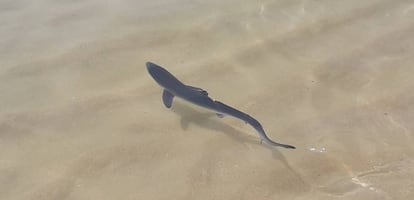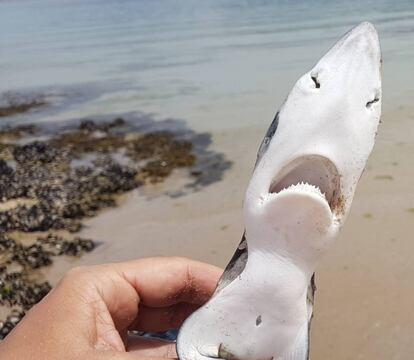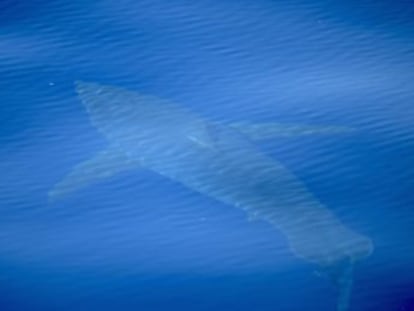The mystery of the blue shark sightings in Galicia
‘Prionace glauca’ pups, which are not a threat to humans, have been coming close to the Spanish shore

They measure around half a meter and slice through the water with an alarming speed, bringing up memories of movie scenes where the characters scream out in panic as they are attacked by sharks. Yet these small creatures are, in fact, fearful and harmless.
The young of the blue shark (Prionace glauca) are an increasingly common sight off the coast of Galicia, in northwestern Spain. It is a trend that has bewildered marine specialists since 2012. Just days ago, 16 pups turned up at Valdoviño beach, prompting the lifeguards to clear the sea of bathers.
They eat small fish and cephalopods and they are fearful and quick to take flight
Gonzalo Mucientes, Blue Ecology
Every summer for the past seven years, these sharks have made an appearance along this coast. Initially, workers at the Coordination Center for the Study of Marine Mammals (Cemma) believed that they had been caught accidentally by fishermen and returned to the sea with injuries, causing them to be dragged by currents to the shore. “Over the past three or four years, we have realized that this is not the case – that it is an ongoing phenomenon,” says Alfredo López, a biologist with Cemma, which was founded in Galicia almost 30 years ago.
These peculiar visitors are just weeks or months old, and are coming into Galicia’s estuaries and even ports for food, at times in large groups, according to Gonzalo Mucientes, from the Blue Ecology association. A marine biologist specializing in the species, he has drawn up a register of summer shark sightings in conjunction with Cemma and the “Sharks in Galicia” blogger Toño Maño in a bid to figure out what is going on, though the investigation has not yet yielded any solid conclusions.
Last year saw the largest number of sightings – 123 registered – with more than 200 blue sharks seen along the coast of Galicia, from the Rías Baixas to Ferrol. By comparison, in 2016 and 2017 combined there were 65 sightings comprising 106 sharks, according to data presented by the researchers at the 7th Iberian Ichthyology Congress in Portugal. The specialists pointed out that the increase does not necessarily mean more blue sharks, but rather a more efficient surveillance network.

Mucientes has two theories to explain the blue sharks’ presence. “On one hand, they might be pushing their nursery zone closer the coast due to a change in water temperature,” he says. “On the other, there may be an increase in the number of young, leading them to come close [to land] as they compete for food.”
Blue sharks have between 30 and 40 pups per litter, after a gestation period of between nine and 12 months during which time food is passed from mother to babies through a tube not unlike the umbilical cord. This takes place out at sea, beyond the Galicia sea bank, located 200 miles offshore. The anomaly is that these pups are traveling that enormous distance to the coast.
But according to Mucientes, the threat they pose is negligible. “They eat small fish and cephalopods and they are fearful and quick to take flight,” he says, adding: “They could be harmful without wanting to be if someone caught them, as they have teeth.”
The increase does not necessarily mean more blue sharks, but rather a more efficient surveillance network
Cemma researchers also insist these sharks are harmless, though they approve of the lifeguards’ response in Valdoviño as, due to their numbers, there was a fair chance of touching one accidentally, which could lead to an involuntary bite. At Valdoviño, the blue sharks were mistaken for short-fin mako sharks, which are also inoffensive but cause more panic due to their large teeth and speed – they are the world’s fastest shark.
The baby blues such as those in Valdoviño will not approach anything bigger than themselves, although Cemma’s advice includes leaving them alone. The organization also suggests returning stranded blue sharks to the sea using a towel and avoiding the dorsal fin. Beachgoers should call 112 or inform lifeguards if they come across one on the sand.
The visiting blue shark phenomenon is mainly confined to Galicia, though there have been sightings off the coast of Asturias and Portugal as well. Mucientes believes that it is due to certain features specific to the Galician coast, such as the estuaries, which form small pools of calm water.
English version by Heather Galloway.
Tu suscripción se está usando en otro dispositivo
¿Quieres añadir otro usuario a tu suscripción?
Si continúas leyendo en este dispositivo, no se podrá leer en el otro.
FlechaTu suscripción se está usando en otro dispositivo y solo puedes acceder a EL PAÍS desde un dispositivo a la vez.
Si quieres compartir tu cuenta, cambia tu suscripción a la modalidad Premium, así podrás añadir otro usuario. Cada uno accederá con su propia cuenta de email, lo que os permitirá personalizar vuestra experiencia en EL PAÍS.
¿Tienes una suscripción de empresa? Accede aquí para contratar más cuentas.
En el caso de no saber quién está usando tu cuenta, te recomendamos cambiar tu contraseña aquí.
Si decides continuar compartiendo tu cuenta, este mensaje se mostrará en tu dispositivo y en el de la otra persona que está usando tu cuenta de forma indefinida, afectando a tu experiencia de lectura. Puedes consultar aquí los términos y condiciones de la suscripción digital.
More information
Archived In
Últimas noticias
A survivor’s account of the Interoceanic Train accident: ‘We were scared because of the speed on the curve’
The Interoceanic Train, the Mexican alternative to the Panama Canal
What is known about the Interoceanic Train derailment in Oaxaca
Trump turns a Minnesota fraud allegation into ammunition for his MAGA army against Democrats
Most viewed
- Oona Chaplin: ‘I told James Cameron that I was living in a treehouse and starting a permaculture project with a friend’
- Reinhard Genzel, Nobel laureate in physics: ‘One-minute videos will never give you the truth’
- Why the price of coffee has skyrocketed: from Brazilian plantations to specialty coffee houses
- Pablo Escobar’s hippos: A serious environmental problem, 40 years on
- Chevy Chase, the beloved comedian who was a monster off camera: ‘Not everyone hated him, just the people who’ve worked with him’











































